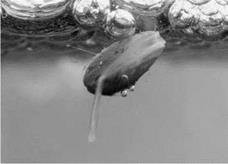In dental treatment, adhesives are in permanent contact with the human body. The methacrylate adhesives which are used as filling materials set rapidly under the effect of light, which is the only setting procedure suited to this field of application. Glass ionomer cements also set under the effect of light, and are used for orthodontic treatment with molar bands and brackets [71].
Methyl methacrylate bone cements have been used for many years to fix endoprostheses (e. g. hip joint). Medically approved polyurethanes and neutral cure silicones are used for implantable devices [69].
Tissue adhesives, which also remain in contact with the body over several months, must be resistant to humid environments and compatible with endogenous tissues. Tissue adhesives are derived from natural and synthetic materials.
Medically approved cyanoacrylates (2-octyl cyanoacrylate, n-butyl-2-cyanoacrylate) are used to replace conventional sutures of flesh wounds. They are also employed in plastic surgery [72, 73].
Histoacryl Blue is a topical skin adhesive and consists of n-butyl-2-cyanoacrylate which, in the presence of moisture on the skin, polymerizes in seconds. The adhesive contains a blue dye in order to make it easier to see when it is being applied (Figure 8.79) [74].
Cyanoacrylates are also used to repair the middle ear membrane, to prevent embolism in case of arteriovenous anomaly of the brain, to repair the retina, for bone stabilization, and to repair perforations of the sclera and cornea. Other areas of applications are the treatment of liver wounds, herniae (inguinal tissue rupture), perineotomies and trocar incision sites. By hydrolysis, the adhesive is primarily metabolized into formaldehyde and alkyl cyanates, which are later excreted. Surgeons use special ampoules or electronic pumps to apply cyanoacrylates, which form a strong tissue bond within 60 s [71, 75, 76].
Fibrin is an endogenous adhesive formed during coagulation by combination of fibrinogen and thrombin in the presence of factor XIII and calcium. Factor XIII is contained in fibrinogen, and mixing both substances directly initiates the blood coagulation cascade. The fibrinogen and thrombin components are typically delivered
|
Figure 8.79 Application of Histoacryl, a topical skin adhesive. (Illustration courtesy of Braun). |
in lyophilized form and reconstituted later; they are applied separately to the wound using a double syringe with blunt cannula. After application, the sealant becomes viscous, adheres to the wound or incision, and immediately forms a fibrin network. Larger areas are sealed using a spray-on application of the adhesive, while severe hemorrhages are sealed with a sponge or fleece. Fibrin is used in thoracic and cardiovascular surgery (sealing of lung leaks and esophageal leaks or splenic, liver and kidney lesions), in neurology [sealing of cerebrospinal fluid (CSF) leaks], and in ophthalmology [75, 77-79].
Gelatin-resorcinol formaldehyde (GRF) tissue adhesive is produced from gelatin, resorcinol and water in the presence of formaldehyde and glutaraldehyde. GRF was used for aortic dissection repair [80] and enhances hemostasis in hepatic or renal vein resections [75].
Gelatin-resorcinol pentanedial ethanedial (GR-DIAL) adhesive is produced from gelatin, resorcinol and water in the presence ofpentanedial and ethanedial; the latter are hardeners which determine the setting rate of the adhesive. GR-DIAL has been used for aortic dissection repair [80].
A synthetic absorbable hydrogel derived from polyethylene glycol (PEG) is used for the sealing of vessels in a wide range of indications, including peripheral bypass grafts, dialysis grafts, aortic aneurysms [81] and air leaks in lung surgery [76].
Collagen gel seals all forms of bleedings in the heart, blood vessels and spine surgery. In combination with endogenous plasma, collagen and thrombin suspensions are used for hemostasis [72]. A mixture of collagen, thrombin and endogenous fibrinogen seals CSF leaks in cranial and spine surgery [81].
Adhesive protein plaque is found on the tips of byssal threads formed by mussels (a mussel forms around 50-100 adhesive threads). The main component of these proteins is an adhesion molecule called Mytilus edulis foot protein (Mefp-I; Figure 8.80; see also Section 8.15) [82]. The biodegradable protein is composed of 17 amino acids, and can be used for the fixture of chondrocytes and osteoblasts [75].
Prolamin gel is also a biodegradable protein, and is used for the intravascular sealing of arteries in tumor resection and for the temporary sealing of the pancreas during transplantation [75].
|
Figure 8.80 Mussel (Mytulis edulis) with byssus threads and foot on an aquarium glass; the mussel diameter is approximately 1.5 cm. (Photo courtesy ofIFAM). |
In combination with glutaraldehyde, bovine serum albumin (BSA) seals CSF leaks in the surgery of pituitary gland tumors and hemorrhages associated with the use of ventricular devices [83]. Another field of application for BSA is in aortic dissection surgery [79].
Many medical adhesives and sealants are currently under intense development, and novel products are being continuously approved for use in the medical sector.
 14 января, 2016
14 января, 2016  Pokraskin
Pokraskin 

 Опубликовано в рубрике
Опубликовано в рубрике 